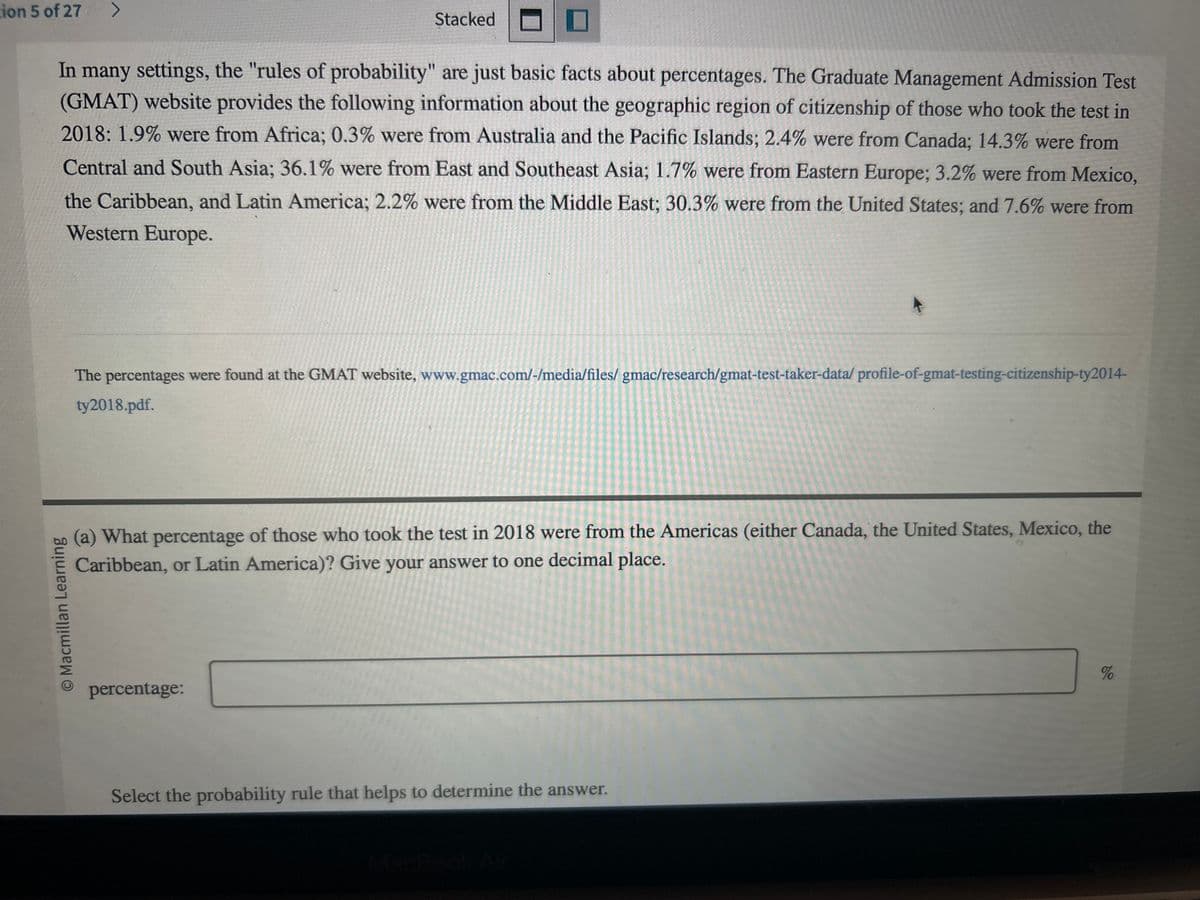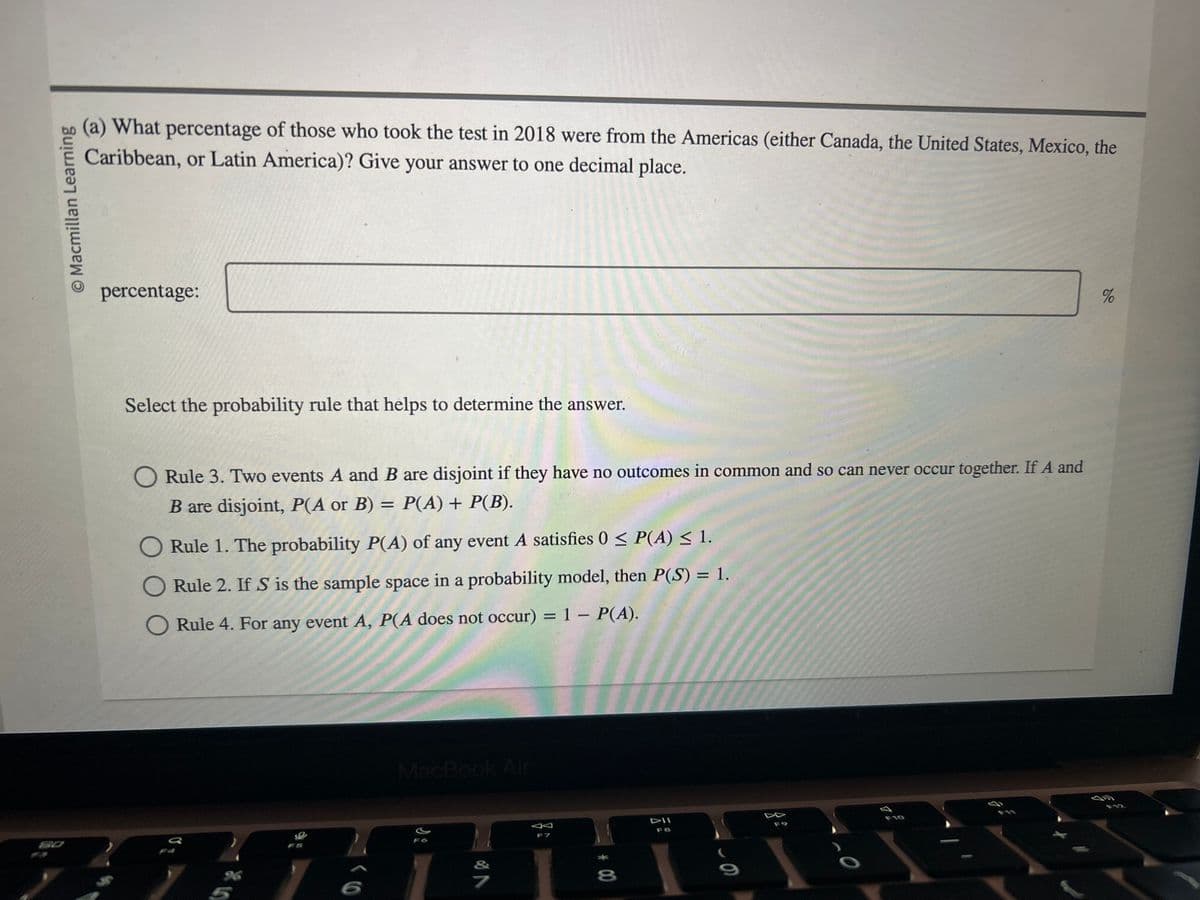In many settings, the "rules of probability" are just basic facts about percentages. The Graduate Management Admission Test (GMAT) website provides the following information about the geographic region of citizenship of those who took the test in 2018: 1.9% were from Africa; 0.3% were from Australia and the Pacific Islands; 2.4% were from Canada; 14.3% were from Central and South Asia; 36.1% were from East and Southeast Asia; 1.7% were from Eastern Europe; 3.2% were from Mexico, the Caribbean, and Latin America; 2.2% were from the Middle East; 30.3% were from the United States; and 7.6% were from Western Europe. Macmillan Learning The percentages were found at the GMAT website, www.gmac.com/-/media/files/gmac/research/gmat-test-taker-data/ profile-of-gmat-testing-citizenship-ty2014- ty 2018.pdf. (a) What percentage of those who took the test in 2018 were from the Americas (either Canada, the United States, Mexico, the Caribbean, or Latin America)? Give your answer to one decimal place. percentage: Select the probability rule that helps to determine the answer. %
In many settings, the "rules of probability" are just basic facts about percentages. The Graduate Management Admission Test (GMAT) website provides the following information about the geographic region of citizenship of those who took the test in 2018: 1.9% were from Africa; 0.3% were from Australia and the Pacific Islands; 2.4% were from Canada; 14.3% were from Central and South Asia; 36.1% were from East and Southeast Asia; 1.7% were from Eastern Europe; 3.2% were from Mexico, the Caribbean, and Latin America; 2.2% were from the Middle East; 30.3% were from the United States; and 7.6% were from Western Europe. Macmillan Learning The percentages were found at the GMAT website, www.gmac.com/-/media/files/gmac/research/gmat-test-taker-data/ profile-of-gmat-testing-citizenship-ty2014- ty 2018.pdf. (a) What percentage of those who took the test in 2018 were from the Americas (either Canada, the United States, Mexico, the Caribbean, or Latin America)? Give your answer to one decimal place. percentage: Select the probability rule that helps to determine the answer. %
Holt Mcdougal Larson Pre-algebra: Student Edition 2012
1st Edition
ISBN:9780547587776
Author:HOLT MCDOUGAL
Publisher:HOLT MCDOUGAL
Chapter11: Data Analysis And Probability
Section11.8: Probabilities Of Disjoint And Overlapping Events
Problem 2C
Related questions
Question

Transcribed Image Text:cion 5 of 27 >
Stacked O
In many settings, the "rules of probability" are just basic facts about percentages. The Graduate Management Admission Test
(GMAT) website provides the following information about the geographic region of citizenship of those who took the test in
2018: 1.9% were from Africa; 0.3% were from Australia and the Pacific Islands; 2.4% were from Canada; 14.3% were from
Central and South Asia; 36.1% were from East and Southeast Asia; 1.7% were from Eastern Europe; 3.2% were from Mexico,
the Caribbean, and Latin America; 2.2% were from the Middle East; 30.3% were from the United States; and 7.6% were from
Western Europe.
O Macmillan Learning
The percentages were found at the GMAT website, www.gmac.com/-/media/files/ gmac/research/gmat-test-taker-data/ profile-of-gmat-testing-citizenship-ty2014-
ty2018.pdf.
(a) What percentage of those who took the test in 2018 were from the Americas (either Canada, the United States, Mexico, the
Caribbean, or Latin America)? Give your answer to one decimal place.
percentage:
Select the probability rule that helps to determine the answer.
%

Transcribed Image Text:cion 5 of 27 >
Stacked O
In many settings, the "rules of probability" are just basic facts about percentages. The Graduate Management Admission Test
(GMAT) website provides the following information about the geographic region of citizenship of those who took the test in
2018: 1.9% were from Africa; 0.3% were from Australia and the Pacific Islands; 2.4% were from Canada; 14.3% were from
Central and South Asia; 36.1% were from East and Southeast Asia; 1.7% were from Eastern Europe; 3.2% were from Mexico,
the Caribbean, and Latin America; 2.2% were from the Middle East; 30.3% were from the United States; and 7.6% were from
Western Europe.
O Macmillan Learning
The percentages were found at the GMAT website, www.gmac.com/-/media/files/ gmac/research/gmat-test-taker-data/ profile-of-gmat-testing-citizenship-ty2014-
ty2018.pdf.
(a) What percentage of those who took the test in 2018 were from the Americas (either Canada, the United States, Mexico, the
Caribbean, or Latin America)? Give your answer to one decimal place.
percentage:
Select the probability rule that helps to determine the answer.
%
Expert Solution
This question has been solved!
Explore an expertly crafted, step-by-step solution for a thorough understanding of key concepts.
This is a popular solution!
Trending now
This is a popular solution!
Step by step
Solved in 3 steps with 1 images

Recommended textbooks for you

Holt Mcdougal Larson Pre-algebra: Student Edition…
Algebra
ISBN:
9780547587776
Author:
HOLT MCDOUGAL
Publisher:
HOLT MCDOUGAL


Holt Mcdougal Larson Pre-algebra: Student Edition…
Algebra
ISBN:
9780547587776
Author:
HOLT MCDOUGAL
Publisher:
HOLT MCDOUGAL
